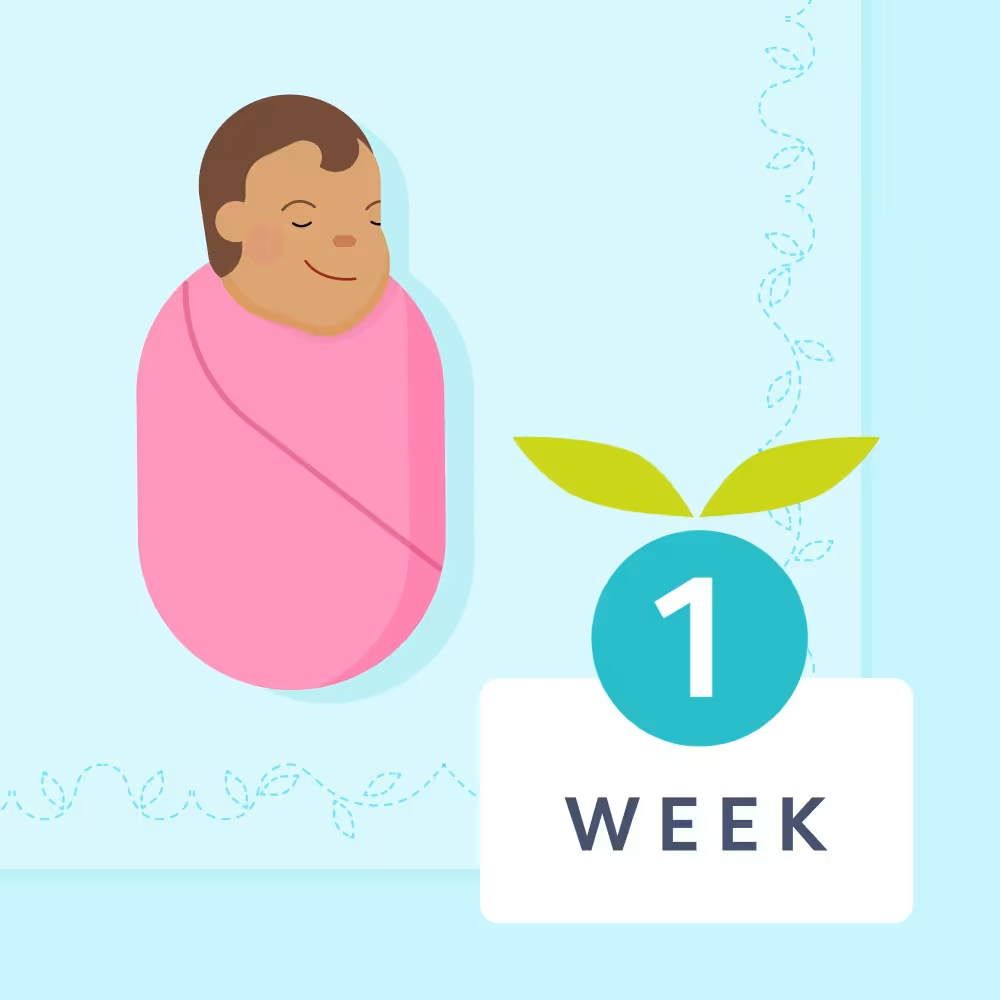Newborn hunger cues: How to know when it’s time to feed your baby
Updated Oct 17, 2025

You’re just getting to know your brand-new bundle of joy in the newborn phase. If only they could tell you what they need, things would be a lot easier! Though your little one can’t say “I’m hungry” just yet, they can communicate their needs through various cues, which are signs they display to show they’re ready to eat.
Learning about your baby’s hunger cues and feeding them before they’re too hungry or upset is helpful for setting a solid feeding foundation for your baby and improving their overall well-being. It’s good for your relationship too — being responsive to your baby’s needs improves parent-child bonding.
In this article, we’ll describe the most common newborn hunger cues, explain how to differentiate between hunger cues and other needs, and discuss why it’s helpful to respond to early hunger cues.
What are newborn hunger cues?
There can be a learning curve as you figure out . However, paying attention to signals from your baby can help you figure out when they’re hungry so you can respond accordingly. These signs from your little one are aptly called “hunger cues.” While there are many common baby hunger cues (we’ll discuss these below), specific cues can vary widely between infants. As you get to know your baby, you’ll likely start to pick up on what their unique hunger cues are, even if they vary from the norm [].
Early hunger cues in newborns
By learning what your baby’s early hunger cues are, you can respond to them before they get so hungry that they get upset. These early cues can be fleeting and subtle, though. It might take you some time to learn what your baby’s specific cues are, and you might miss the cues sometimes, too. That’s OK!
Early hunger signs in newborns can include []:
Bringing their fist to their mouth
Turning their head to look for the breast or bottle and opening their mouth (often referred to as rooting)
Increasing alertness and activity
Sucking on their hands, clothes, or toys
Smacking their lips
Opening and closing their mouth
Sticking their tongue out
Feeding your baby when they exhibit hunger cues is also known as responsive feeding. By feeding your baby when they show signs that they’re hungry and stopping when they show signs that they’re full, you can help provide your baby with a good foundation of []. Your baby might tell you they’re full by unlatching from the breast or bottle, turning their head away, relaxing their body, and opening their fists [].
If it seems like your baby is exhibiting hunger cues frequently, that’s probably because they are! Typical newborn feeding patterns for breastfed babies involve eating about every 2 - 3 hours [], starting from the beginning of their last feed. This means they might eat 8 - 12 times in 24 hours []. Formula-fed babies typically stay full a bit longer and eat every 2 - 3 hours, eating about 8 times in 24 hours []. During certain times, your baby may also cluster feed, wanting to eat more frequently over a shorter period—this is normal and often happens during growth spurts or in the evening [].
How to differentiate between hunger and other needs in newborns
Babies communicate their various needs in many different ways, and one of their main forms of communication is crying. Crying, however, does not always mean that your baby is hungry.
Newborns can cry because they’re uncomfortable, cold, hot, in pain, tired, or in need of a diaper change []. Sometimes, you may not be able to figure out why your baby is crying. However, over time, you’ll likely start to become more in tune with your baby, and it will get easier for you to determine what their different cries mean.
Here are some ways you can decipher your baby’s cries:
In addition to crying, if your baby is tired, they might stare into the distance, yawn, have jerky movements, or lose interest in people and toys [].
To determine if your baby is too hot or cold, compare their clothing to your own. In general, babies are comfortable when they have one more layer on than you do [].
Babies typically need frequent diaper changes throughout the day. If it's been longer than 2-3 hours and your baby is crying, a soiled diaper may be to blame [].
Why responding to newborn hunger cues is important
Being in tune to your baby’s hunger cues is important for meeting their nutritional needs and their emotional development. According to the American Academy of Pediatrics (AAP), responding when your baby is hungry can help them develop healthy eating habits, lower their risk of becoming overweight, and make mealtimes easier [].
Responding to hunger cues can also help them bond with you. Babies eat because they’re hungry, but they also eat to feel love and comfort []. When you respond to those emotional needs, you’re reassuring your baby and showing them that you’re there for them. Plus, hungry babies have a harder time falling asleep, so recognizing and addressing hunger cues can also help promote better rest for your little one.
When you respond to hunger cues early, you can ideally prevent your baby from escalating to later hunger cues, such as crying, becoming increasingly fussy, and frantically moving their head and body. Once babies become fussy and overly hungry, it may be harder to calm them down enough for a feeding.
Practical tips for recognizing and responding to newborn hunger cues
Learning to recognize hunger cues in newborns and responding to them appropriately is important for baby’s growth and development. Here are some tips to help:
Tip #1: Look for early cues and respond
Paying attention to your baby’s early hunger cues, like rooting, sucking on their hands, or smacking their lips, can help you decide when to offer a feeding. If they seem interested, you can give it a try, but there’s no need to worry if they’re not ready to eat. If your baby turns their head or pushes away, it may mean they’re not hungry or they’ve had enough. That’s perfectly fine — just try again later when they might be more interested.
Tip #2: Attempt to recognize hunger vs. discomfort vs. tiredness
Learning what your baby typically does when they’re hungry, uncomfortable, and tired can help you decode any signs of distress. You can also run through a checklist of what your baby might need. If they’re not hungry, try things like checking their diaper, seeing if they’re hot or cold, or offering a nap.
Tip #3: Offer regular feedings since hunger cues may be fleeting or easy to miss
If your baby doesn’t seem to be displaying obvious hunger cues, that’s normal too. Offering the breast or bottle every 2 - 3 hours if you don’t notice any hunger cues can ensure your little one is getting enough to eat. If you’re concerned about how much your baby is eating, monitor their wet diapers (babies should have at least 6 wet diapers per day after the first 4 days []) and reach out to their doctor with any questions.
Tip #4: Keep track of feedings
Though the AAP recommends responsive feeding (unless otherwise directed by your baby’s doctor), noting when your child last ate can help anticipate when they may be hungry again. Parents have so many things on their minds that it may be tricky to remember when their baby last ate. A great way to quickly and easily track your baby’s feedings (breast, bottle, or tube) is in .
Tip #5: Set realistic expectations for the newborn phase
Life with a newborn often feels chaotic — with lots of snuggles and sweetness too. There will probably be times when you miss hunger cues or feel like you just can’t figure your baby out. You and your baby are both learning how to do this for the first time.
It’s normal and expected to feel like all your newborn is doing is eating, sleeping, and needing diaper changes. It’s also expected that your newborn will wake overnight for feedings and comfort. This is often exhausting, but this phase won’t last forever. More predictable cycles of feeding and sleeping generally happen by 3 - 4 months.
Takeaway
Early newborn hunger cues can include bringing their fist to their mouth, rooting, increasing alertness, sucking on hands, smacking lips, opening and closing their mouth, and sticking their tongue out.
Responding to early hunger cues can prevent your baby from escalating to later hunger cues like becoming fussy and crying. It also promotes a healthy bond and sets your baby up for a positive relationship with feeding.
Keep in mind hunger cues can be fleeting and easy to miss. Some babies may not display obvious hunger cues. In these cases, paying attention to the time between your baby’s feedings and regularly offering feedings can ensure your little one gets the nutrition they need to grow and thrive.
Newborn hunger cues FAQ
Share article:
Note: The content on this site is for informational purposes only and should not replace medical advice from your doctor, pediatrician, or medical professional. If you have questions or concerns, you should contact a medical professional.
12 Sources
Share article:






